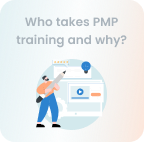







 10 Sep 2024
10 Sep 2024



Imagine you’re at a pivotal moment in an Agile project, facing a daunting challenge. How do you ensure your team overcomes it? The secret lies in mastering the PMI ACP Exam Questions. This blog is your essential resource for navigating these questions and answers with ease.
By exploring the PMI ACP Exam Questions, you’ll gain the critical insights needed to excel in Agile Project Management. Whether you’re a seasoned pro or just beginning your Agile journey, this blog will equip you with the knowledge to tackle any project scenario. Let’s dive in and unlock the full potential of Agile together!
Table of Contents
1) Top PMI ACP Sample Questions
a) Which of the following is not a principle of the Agile Manifesto?
b) Which of the following does NOT qualify as an Information Radiator?
c) In the MoSCoW prioritization method, what does the "C" stand for?
d) Which statement about velocity is incorrect?
e) Which of the following is NOT considered an agile value?
f) Which of the following is not one of the core agile values?
g) Which Agile meeting focuses on the process?
h) According to the Kano model, which items are the minimal requirements for customer satisfaction?
i) In Agile Project Management, how is Risk Management addressed?
j) If your team has 400 points in the backlog and a velocity of 25 points per two-week iteration, how many iterations will be needed to complete the project?
2) Conclusion
Mastering the PMI ACP Exam Questions is crucial for anyone looking to excel in Agile Project Management. These questions not only test your knowledge but also prepare you for real-world scenarios. By practicing with sample questions, you can figure out improvement areas and build confidence. Here are some top Project Management Institute Agile Certified Practitioner (PMI ACP) sample questions to help you get started:
a) Our highest priority is to fulfil the customer via early and continuous delivery of valuable software.
b) Working software is the core measure of progress
c) Simplicity is the art of maximizing the amount of work not done
d) Business people and developers must work independently of each other
Answer: D
Explanation: The correct principle is Business people and developers should collaborate daily throughout the project.

a) Work Breakdown Structure (WBS)
b) Iteration Planning
c) Project Status
d) Automated build report

Answer: B
Explanation: Iteration planning is a phase within the project, not merely information being presented
a) Can Do
b) Could Have
c) Couldn’t Do
d) Cancel
Answer: B
Explanation: MoSCoW is a prioritization technique. Ignoring the O’s, the prioritization terms are M, S, C, and W. M represents Must haves, S stands for Should haves, C denotes Could haves, and W signifies Won’t and Would haves.
a) Velocity is the measure of work, which a team can handle in a single iteration
b) Velocity is used to track progress
c) Velocity can be used to compare teams
d) Velocity can be applied to project how much work an agile team can do
Answer: B
Explanation: Velocity cannot be used to compare teams, as each team has its own unique calibration of velocity.
a) Individuals and interactions over tools and processes
b) Comprehensive documentation over operational software
c) Customer collaboration over contract negotiation
d) Responding to change over following a plan
Answer: B
Explanation: Working software over comprehensive documentation.
a) Customer Collaboration over Technical Quality
b) Individuals and Interactions over Processes and Tools
c) Working Software over Detailed Documentation
d) Responding to Change over Following a Plan
Answer: C
Explanation: The value emphasizes Customer Collaboration over Contract Negotiation
a) Iteration Planning
b) Iteration Review
c) Iteration Demonstration
d) Iteration Retrospective
Answer: D
Explanation: The Iteration Retrospective is a process-focused Agile team meeting conducted at the end of each iteration. Its goal is to reflect on the most significant events of the current iteration to make decisions on improving processes for the next iteration.
a) Exciters
b) Linear features
c) Threshold
d) Delighters
Answer: C
Explanation: Threshold features are essential components of the product. They must be included to ensure the product’s success.
a) Inherent Risk Management
b) Organic Risk Management
c) Overt Risk Management
d) Intrinsic Risk Management
Answer: B
Explanation: In Agile projects, Risk Management can be classified as either ‘Organic’ or ‘Overt’. Organic Risk Management naturally occurs by adhering to Agile best practices like iterative planning and reviews. Overt Risk Management involves specific strategies to identify, assess, and mitigate risks using Agile tools and techniques, such as Risk-Based Spikes, Risk-Adjusted Backlogs, and Risk Burndown Charts.
a) 16 weeks
b) 20 weeks
c) 40 weeks
d) 28 weeks
Answer: A
Explanation: 400/25 = 16 iterations
a) Define and Visualize the Workflow, Make Process Policies Clear, Simplicity
b) Limit WIP, Make Process Policies Clear, Measure and Manage Flow
c) Limit WIP, Use Models to Guide Improvement, Prioritize Business Value
d) Define and Visualize the Workflow, Self-Organization, Measure and Manage Flow
Answer: D
Explanation: The five core practices of Kanban are: defining and visualizing the workflow, limiting WIP, measuring and managing flow, making process policies explicit, and using models to suggest improvements. In answer B, self-organizing is a primary concern in Scrum. In answer C, prioritizing business value is a general Agile philosophy. In answer A, simplicity is a core value of XP.
a) Exploratory Testing
b) Alpha Testing
c) Usability Testing
d) Scenario Testing
Answer: A
Explanation: Exploratory Testing involves testers conducting unscripted testing.
a) Shield the team from interruptions
b) Remove Impediments to progress
c) Communicate (and re-communicate) the project vision
d) Carry Food and Water
Answer: D
Explanation: Ensuring the team has food and water goes beyond mere provision; it’s about supplying the vital resources needed to keep them nourished and productive. Additionally, showing appreciation is crucial for maintaining their motivation and productivity.
a) Scrum Master
b) Scrum Team
c) Product owner
d) Quality Manager
Answer: B
Explanation: The Scrum team is tasked with monitoring the total remaining work in the sprint backlog to ensure the sprint goal is achieved.
a) 180
b) 18
c) 30
d) 190
Answer: B
Explanation: Number of iterations = Total story points / Velocity = 180/10 = 18
a) Sustainable Pace
b) Simple Design
c) System Metaphor
d) Pair Programming
Answer: C
Explanation: System Metaphor is a tool used to create a shared understanding within the team. While option B, which suggests the design might be too complicated, could be considered, C remains the optimal choice.
a) Schedule a conference call with the stakeholders
b) Go discuss the issue face to face with the stakeholders
c) Text the Product Owner
d) Write a report documenting what occurred
Answer: B
Explanation: The most effective way to communicate, particularly when delivering bad news, is face-to-face.
a) Nothing is wrong. Maintaining a fixed pace indefinitely is more important than missing a sprint goal.
b) The team approach is incorrect. Maintaining a constant pace indefinitely has a separate meaning that is not applicable in this scenario.
c) Nothing is wrong. To have good working relationships with the team, the Product Owner should not account the team.
d) The team approach is wrong. The team should satisfy and be held accountable for their commitment.
Answer: D
Explanation: The Agile Manifesto should not serve as an excuse for failing to meet the committed sprint goal. The team must be held accountable for their work.
a) Social Awareness is characterized by the use of empathy
b) Social Awareness is characterized by the use of self-control
c) Social Awareness is characterized by the use of self-confidence
d) Social Awareness is characterized by the use of influence
Answer: D
Explanation: In an Agile project, employing the interpersonal skill of Emotional Intelligence involves using Social Awareness, which is defined by the ability to empathize and understand the perspective of the person you are interacting and communicating with.
a) Agile Prototyping
b) Agile Analytics
c) Agile Modeling
d) Agile Diagnostics
Answer: C
Explanation: Agile Modeling is a tool frequently utilized by Agile project teams to develop models for Agile software development. It encompasses a collection of values, principles, and practices.
Mastering the PMI ACP Exam Questions is your gateway to Agile excellence. Equip yourself with the right answers and insights to navigate the complexities of Agile projects. Stay ahead, stay informed, and let your Agile journey soar!






© Copyright 2025. All rights reserved. Contact: PMP® TRAINING ACADEMY.


